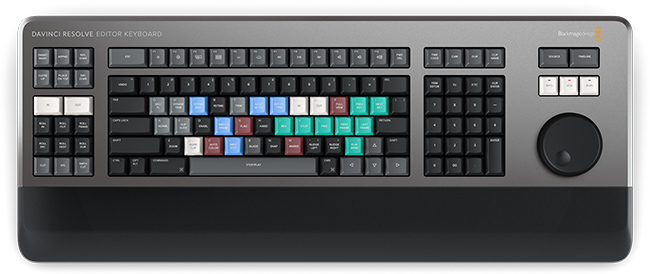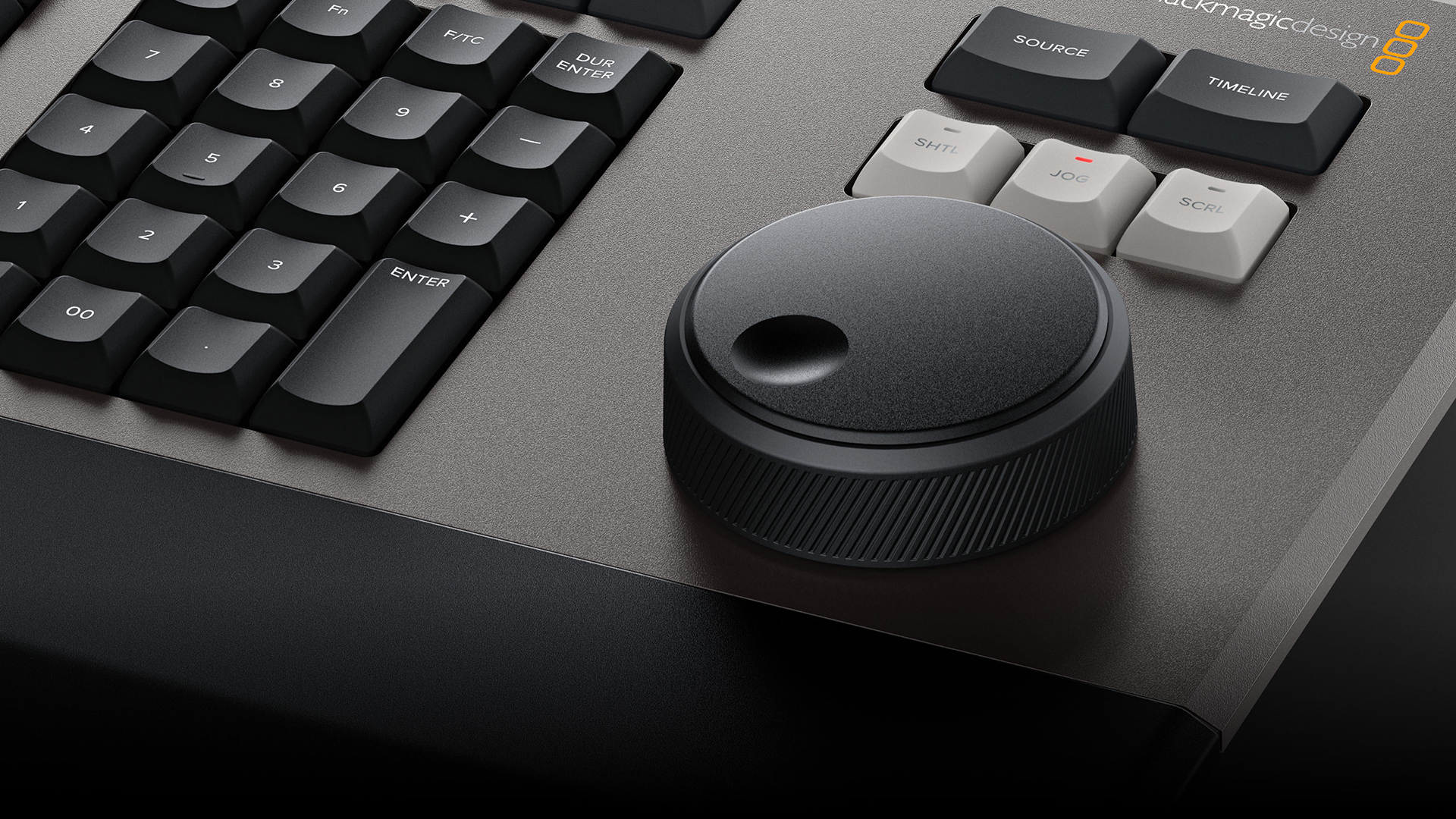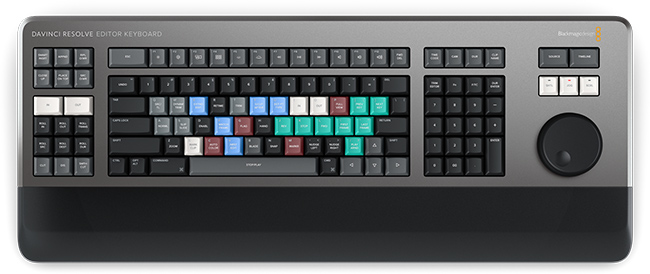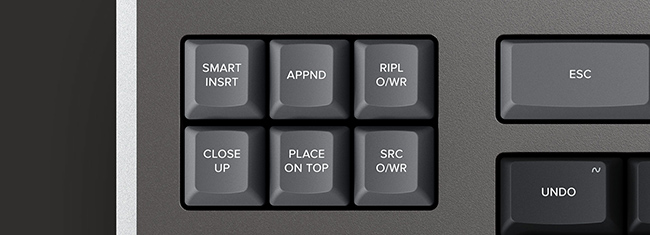

Replay: Blackmagic Design doubled-down on advanced editing features in 2019 by introducing a new editing mode to DaVinci Resolve 16 called the cut page. They also added a dedicated editor's keyboard - something that warms the heart of any editor who started their career in a linear edit suite. After some post-NAB feedback and adjustment, the keyboard is finally ready for prime time, running with DaVinci Resolve 16.1 (currently in public beta) or later.
Blackmagic Design's Grant Petty comes from a broadcast engineering background and knows how fast tape editing was with the right controller. Speed is lost using a mouse-centric, drag-and-drop approach, so the DaVinci Resolve keyboard is designed to put speed back into modern edit workflows. Blackmagic Design was kind enough to loan me a keyboard for a couple of weeks of testing for this review.
Hardware design
The keyboard is very reminiscent of Sony's BVE keyboards of the past. That's not simply cosmetic - there are a number of plastic editing keyboards with a shuttle knob - it's about precision engineering. The DaVinci Resolve search dial (job/shuttle/scroll wheel) truly feels like it has the same type of ballistics and tactile feedback that a Sony dial gave you. The DaVinci Resolve keyboard is built into a sturdy metal case with keycaps that are designed to take some pounding. They intend for the keyboard to last and will offer replacement parts as needed. In short, don't think of this as a product you'll have to toss out in a few years.
The keyboard connects via USB-C. But it also worked on the USB3.0 connection of a two-year old iMac and MacBook Pro by using a USB-A to USB-C cable. The back of the keyboard includes two additional USB-A ports for a thumb drive, mouse, or a DaVinci Resolve license key ("dongle"). The keyboard is wider than a standard extended keyboard due to dedicated edit keys on the left and the search dial on the right. It has a replaceable wrist rest on the front edge and adjustable feet to elevate the keyboard angle.

The Cut Page
The Editor Keyboard is optimized for the cut and edit pages. It does work as a standard keyboard in the color, Fairlight, and Fusion pages. However, I found the dial operation in those modes to be rather finicky. Outside of DaVinci Resolve, it's a generic QWERTY keyboard, but the special edit keys and dial will not work with other editing software.
It's hard to talk about the keyboard without delving into the cut page. While the keyboard works effectively and correctly in the edit page, you'll still find yourself needing the mouse, which defeats the purpose. In short, the design motivation is fast editing where your hands never leave the keyboard. That ideal plays out best in the cut page and the two have been developed in tandem.
While the DaVinci Resolve cut page shares many similarities to Apple's Final Cut Pro X, Blackmagic Design software engineers added a number of unique functions that improve editing speed. The best of these is the source tape view. The bin can be sorted by timecode, camera, duration, or name order and then viewed as if from a single source - essentially a virtual string-out. Quickly scroll through the footage using the search dial as effortlessly as using the FCPX skimming function. Large, dedicated buttons for source and timeline, in and out, and sort methods make for easy navigation and quick assembly. Smart edit and special function buttons, such as the unique "close-up" button (automatically does a basic punch-in of high-res footage), round out the picture.
The cut page itself has a number of other unique features that are beyond the scope of this article. Nevertheless, one unique tool that is worth mentioning is the dual timeline view. The timeline pane is divided into a top mini-display of the full timeline, while the lower area always shows the zoomed-in section of the timeline at the current time indicator (cursor). You never have to zoom in and zoom out to navigate your timeline. The search dial makes it a breeze to quickly scroll through the full timeline (top) and then hit the jog key to zero in on the frame you want (bottom).
Trimming is where the dial shines. Dedicated keys quickly select in-point, out-point, roll, slip, or slide trimming. Simply hit the key and DaVinci Resolve automatically jumps to the nearest cut point. Then use the search dial for the rest. As you adjust the head or tail of a cut the rest of the timeline ripples accordingly. It's one of the best trim models of any NLE.

Some additional thoughts
I do have a few quibbles. Trim functions in the cut and edit pages are inconsistent with each other. The cut page uses a similar model to FCPX, where audio and video from the clip are combined into a single timeline clip rather than on separate tracks. Unfortunately, Blackmagic Design has yet to implement a way to expand a/v clips and perform L-cut or J-cut trimming on the cut page. You'll have to shift to the edit page to perform those.
This is a right-handed device, so left-handed editors will have the same dilemma that left-handed guitar players encounter. In addition, these are imprinted keycaps based on DaVinci Resolve's default keyboard map. If you use a custom layout or one of the other keyboard maps that DaVinci Resolve offers, then the QWERTY command portion of the keyboard becomes less useful.
The search dial will not override the J-K-L or the space bar play commands. In order to jog once the sequence is playing, you must first hit the K key or the space bar to stop playback before you can properly jog through frames. Otherwise, playback continues the minute you let go of the dial.
Conclusion
This keyboard is addictive. But, is its $995 (USD) price tag justified? That's steep, but many plastic gaming keyboards can run up to $200 and some even $500. That's without any extra pointers, dials, or keys. I've also found precision metal keyboards with force-sensitive pointers as high as $3,000. Given that, Blackmagic Design may be in the right ballpark. Just like control surfaces for grading or mixing, this keyboard isn't for everyone. If you are already a fast, keyboard-oriented editor, then the DaVinci Resolve Editor Keyboard may not make you faster. Likewise, a Final Cut Pro X editor who flies by skimming with a mouse is also going to have a hard time justifying the expense, not to mention a shift to a different application.
This keyboard is designed for DaVinci Resolve editors and not colorists. It's for facilities that intend to deploy DaVinci Resolve as their full-time editing application. I could easily see DaVinci Resolve and this keyboard used in a fast turnaround edit environment, like broadcast news. Under that scenario, it will certainly enhance speed and workflow, especially for editors who want to make the most out of the new cut page.
Tags: Post & VFX


Comments